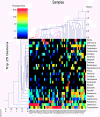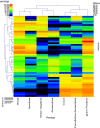Evaluation of the bacterial diversity of pressure ulcers using bTEFAP pyrosequencing
- PMID: 20854691
- PMCID: PMC2955665
- DOI: 10.1186/1755-8794-3-41
Evaluation of the bacterial diversity of pressure ulcers using bTEFAP pyrosequencing
Abstract
Background: Decubitus ulcers, also known as bedsores or pressure ulcers, affect millions of hospitalized patients each year. The microflora of chronic wounds such as ulcers most commonly exist in the biofilm phenotype and have been known to significantly impair normal healing trajectories.
Methods: Bacterial tag-encoded FLX amplicon pyrosequencing (bTEFAP), a universal bacterial identification method, was used to identify bacterial populations in 49 decubitus ulcers. Diversity estimators were utilized and wound community compositions analyzed in relation to metadata such as Age, race, gender, and comorbidities.
Results: Decubitus ulcers are shown to be polymicrobial in nature with no single bacterium exclusively colonizing the wounds. The microbial community among such ulcers is highly variable. While there are between 3 and 10 primary populations in each wound there can be hundreds of different species present many of which are in trace amounts. There is no clearly significant differences in the microbial ecology of decubitus ulcer in relation to metadata except when considering diabetes. The microbial populations and composition in the decubitus ulcers of diabetics may be significantly different from the communities in non-diabetics.
Conclusions: Based upon the continued elucidation of chronic wound bioburdens as polymicrobial infections, it is recommended that, in addition to traditional biofilm-based wound care strategies, an antimicrobial/antibiofilm treatment program can be tailored to each patient's respective wound microflora.
Figures




References
-
- Beckrich K, Aronovitch S. Hospital-acquired pressure ulcers: a comparison of costs in medical vs surgical patients. Nurs Econ. 1999;17:263–271. - PubMed
MeSH terms
Substances
LinkOut - more resources
Full Text Sources
Other Literature Sources
Medical

